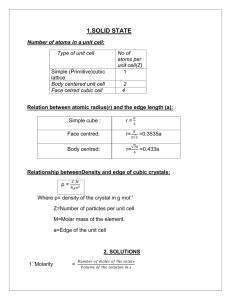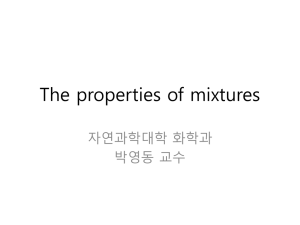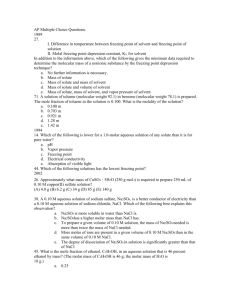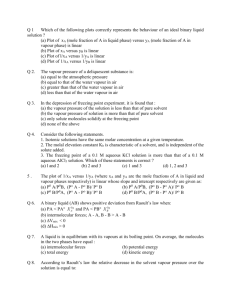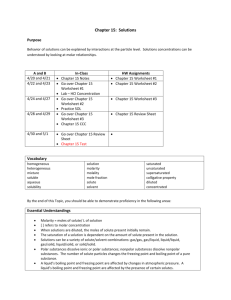chemistry - Kendriya Vidyalaya No.1 Jaipur
advertisement
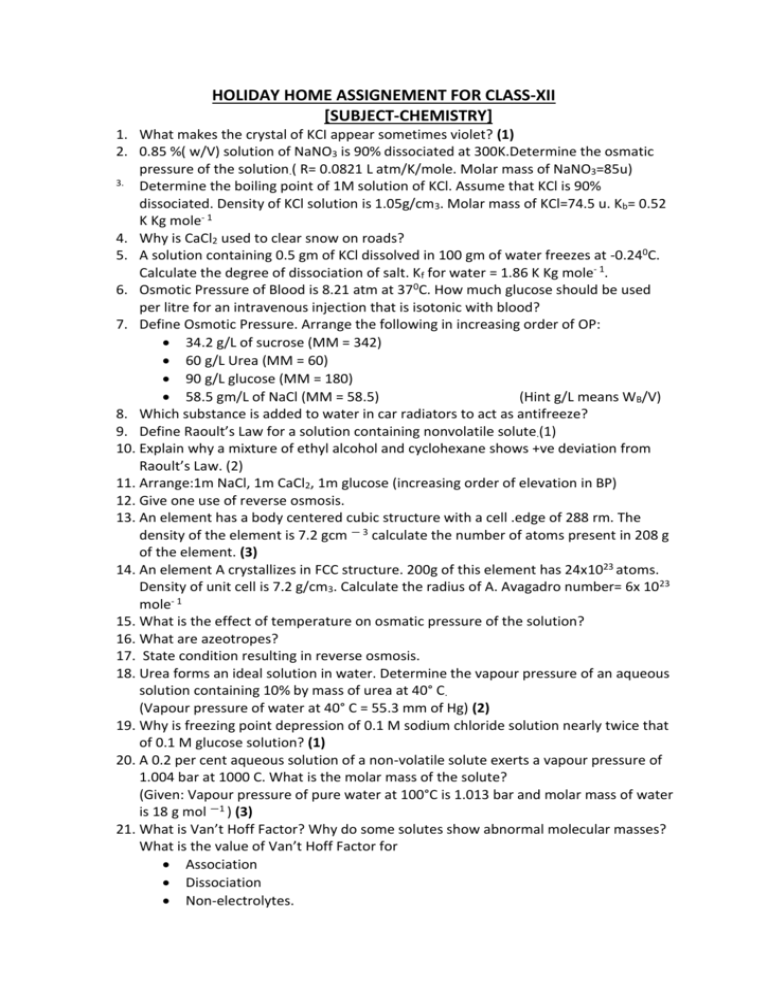
HOLIDAY HOME ASSIGNEMENT FOR CLASS-XII [SUBJECT-CHEMISTRY] 1. What makes the crystal of KCI appear sometimes violet? (1) 2. 0.85 %( w/V) solution of NaNO3 is 90% dissociated at 300K.Determine the osmatic pressure of the solution.( R= 0.0821 L atm/K/mole. Molar mass of NaNO3=85u) 3. Determine the boiling point of 1M solution of KCl. Assume that KCl is 90% dissociated. Density of KCl solution is 1.05g/cm3. Molar mass of KCl=74.5 u. Kb= 0.52 K Kg mole- 1 4. Why is CaCl2 used to clear snow on roads? 5. A solution containing 0.5 gm of KCl dissolved in 100 gm of water freezes at -0.240C. Calculate the degree of dissociation of salt. Kf for water = 1.86 K Kg mole- 1. 6. Osmotic Pressure of Blood is 8.21 atm at 370C. How much glucose should be used per litre for an intravenous injection that is isotonic with blood? 7. Define Osmotic Pressure. Arrange the following in increasing order of OP: 34.2 g/L of sucrose (MM = 342) 60 g/L Urea (MM = 60) 90 g/L glucose (MM = 180) 58.5 gm/L of NaCl (MM = 58.5) (Hint g/L means WB/V) 8. Which substance is added to water in car radiators to act as antifreeze? 9. Define Raoult’s Law for a solution containing nonvolatile solute.(1) 10. Explain why a mixture of ethyl alcohol and cyclohexane shows +ve deviation from Raoult’s Law. (2) 11. Arrange:1m NaCl, 1m CaCl2, 1m glucose (increasing order of elevation in BP) 12. Give one use of reverse osmosis. 13. An element has a body centered cubic structure with a cell .edge of 288 rm. The density of the element is 7.2 gcm — 3 calculate the number of atoms present in 208 g of the element. (3) 14. An element A crystallizes in FCC structure. 200g of this element has 24x1023 atoms. Density of unit cell is 7.2 g/cm3. Calculate the radius of A. Avagadro number= 6x 1023 mole- 1 15. What is the effect of temperature on osmatic pressure of the solution? 16. What are azeotropes? 17. State condition resulting in reverse osmosis. 18. Urea forms an ideal solution in water. Determine the vapour pressure of an aqueous solution containing 10% by mass of urea at 40° C. (Vapour pressure of water at 40° C = 55.3 mm of Hg) (2) 19. Why is freezing point depression of 0.1 M sodium chloride solution nearly twice that of 0.1 M glucose solution? (1) 20. A 0.2 per cent aqueous solution of a non-volatile solute exerts a vapour pressure of 1.004 bar at 1000 C. What is the molar mass of the solute? (Given: Vapour pressure of pure water at 100°C is 1.013 bar and molar mass of water is 18 g mol —1 ) (3) 21. What is Van’t Hoff Factor? Why do some solutes show abnormal molecular masses? What is the value of Van’t Hoff Factor for Association Dissociation Non-electrolytes. 22. Define i) Normality ii) Mole Fraction. 23. Define Raoult’s Law. 24. At 300 K 36 g of glucose (C6 H12 O6) present per litre in its aqueous solution has an osmotic pressure of 4.98 bar. If the osmotic pressure of another solution of glucose is 1.52 bar at the same temperature, what would be its concentration? (3) 25. Explain why addition of solute lowers freezing point of sol. Draw the graph also. 26. A commercially available sample of sulphuric acid contains 25% H2SO4 by weight (density = 1.10 g/ml) Calculate Molarity Normality Molality. 27. Define Van’t Hoff Factor. Why do some solutes show abnormal molar masses? Give the value of Van’t Hoff Factor for i) Association ii) Dissociation iii) Non-Electrolytes. How do colligative properties get modified with help of Van’t Hoff Factor? Give equation only. 28. Two liquids A and B boil at 145°C and 190°C respectively. Which of them has a higher vapour pressure at 80°C? (1) 29. Define and give characteristics of ideal and non-ideal solutions. With the help of graph and examples explain types of non-ideal solutions 30. Define Colligative Property. Show that relative lowering in vapour pressure is equal to mole fraction of solute. 31. What is the expected value of Van’t Hoff Factor for K4[Fe(CN)6]? 32. BP of a solution is always________________ than that of pure solvent. 33. 2 gm each of solute A and B (molar mass A<B) are dissolved separately in 50 gm of solvent. Which will show greater elevation in BP? 34. How is depression in FP related to molecular mass? 35. A 0.1539 molal aq. solution of cane sugar (MM = 342gm) has a FP of 271 K while FP of pure water is 273.15K. What will be FP of a aq solution containing 5 gm of glucose (MM = 180gm) per 100 gm of solution. 36. Explain corrosion of iron as an electro chemical process. 37. Name the metal that can be used in cathodic protection of iron against rusting. 38. What is the reference electrode in determining the standard electrode potential? 39. The unit of equivalent conductance is: 40. What are the units of molar conductivity? 41. Why it is necessary to use a salt bridge in a galvanic cell? 42. Give the relationship between free energy change and EMF of a cell. 43. Which cells were used in the Apollo space program? Discuss its structure & write its anodic and cathodic reactions. 44. What is Galvanization ? 45. Define Kohlrausch’s law. 46. The electrolysis of a metal salt solution was carried out by passing 4 amperes for 45 minutes. It resulted in the deposition of 2.977g of the metal. If atomic mass of the metal is 106.4g/mole, determine the charge carried by the metal ion. 47. How does conductivity and molar conductivity of an electrolyte solution vary with the dilution of the solution? 48. Find the value of equilibrium constant from the following data 49. State the products of electrolysis obtained on the cathode and the anode in the following cases a. A dilute solution of H2S04 with platinum electrodes b. An aqueous solution of AgNO3 with silver electrodes 50. Write the cell formulation and calculate the standard cell potential of the galvanic cell in which the following reaction takes place: Fe2+ (aq) + Ag+ (aq) → Fe3+ (aq) + Ag (s) Calculate ∆ f G° for the above reaction. [Given: E° Ag+ / Ag = + 0.80 V and E° Fe3+ / Fe2+ = + 0.77 V; F = 96500 C mol —1] (2, 3) 51. Calculate standard free energy change for the following chemical reaction – 52. Represent the following cell reactions as galvanic cell– 53. Define and give one example of each of the following Primary Cells Secondary Cell Fuel Cell 54. What is Nernst equation? Write its expression for single electrode and cell. 55. Find the emf of following cell - 56. Define the terms specific conductance and molar conductivity for solutions of electrolytes. 57. Write the cell formulation and calculate the standard cell potential of the galvanic cell in operation of which the following reaction takes place: 2 Cr (s) + 3 Cd2+ (aq) → 2 Cr 3+ (aq) + 3 Cd (s) (2, 3) 58. Explain with an example how weak and strong electrolytes can be distinguished. 59. In the button cell used in watches the following reaction occurs Zn (s) + Ag2 O (s) + H2O (l) → Zn2+ (aq) + 2 Ag (s) + 2 OH-- (aq) Determine E0 for the cell and ∆ r G0 for the reaction. (Given: Zn2+ (aq) + 2e-- → Zn (s); E° = — 0.76 V Ag2 O (s) +2 H2O (l)+ 2e-- →Ag (s) + 2 OH—(aq), E0 = + 0.34 V, F = 96500 C mol—1) 60. What is the effect of schottky and frenkel defect on electrical conductivity? 61. If three elements A,B and Crystallize in a cubic solid lattice with A atoms at the corner. B atoms at cube centre and C atoms at edges then what would be the formula of the solid? 62. Frenkel defect is not found in pure alkali metal halides. Why? 63. What is extrinsic semiconductor? 64. What type of stoichiometric defect is shown AgBr? 65. A face centred cubic element (At. Mass=60) has a cell edge of 400pm. Calculate its density? 66. Account for the following silicon is insulator but silicon doped with phosphorus acts as a semiconductor Some of the glass objects recovered from ancient monuments look milky instead Of being transparent 67. An element crystallizes in FC structure. Its density is 7.2 g/cm3.208 g of this element has 4.283 x 1024 atoms. Calculate edge length of unit cell. 68. Give reasons a)CaCl2 if added to AgCl crystal will introduce schottky defect. b) Amorphous solids are considered as super cooled liquids 69. The electrical conductivity of metals decreases with decreases with temperature while that of semiconductors increases. Explain. 70. A metal crystallizes into two cubic phases, face centred cubic and Bcc whose unit cell length are 3.5A0 and 3.0A0 resp. Calculate the ratio of the densities of FCC and BCC 71. Chromium metal crystallizes with BCC lattice. The unit cell edge length is 287pm.Calculate the atomic radius. What would be the density of chromium in g/cm3? 72. Sodium metal is soft while NaCl crystals are hard. Explain 73. a) Alkali metal halides are sometimes coloured. b) Urea has sharp m.p. but glass does not? 74. How many octahedral voids are there in one mole of a compound having cubic close packed structure? 75. a) What is a photovoltaic cell? b) what happens when ferromagnetic substance is heated to high temperature? c) How does amorphous silica differ from quartz ? 76. a) Which property will determine whether a solid AB having high m.p. and b.p. and rigidity will be ionic or covalent? b) Amorphous solids do not have sharp m.p. 77. In which crystal defect density of crystal remains same? [1] 78. What are the correct relation of axial distances and axial angles in orthorhombic crystal system? [1] 79. Give the name of point defect(s) shown by AgBr. [1] 80. Give one example each of ferromagnetic and ferrimagnetic. [1] 81. What percentage of packing efficiency is present in body centred cubic structure? [1] 82. Give the formula of radius of sphere (r) in fcc unit cell, if the cell edge length is ‘a’. [1] 83. A compound forms cubic close packed structure. What is the total number of voids in 0.6 mol of it? How many of these are tetrahedral voids? [2] 84. Silver (atomic radius = 1.6 Å) crystallises in a face centred unit cell. Calculate the length of the side of unit cell. [2] 85. If NaCl is doped with 10–4 mol% of AlCl3, what is the concentration of cation vacancies? [2] 86. Name the non-stoichiometric point defect responsible for the colour of alkali metals. 87. A compound is formed by A, B and C atoms in ccp, A atoms are present on corners, B atoms are present on faces and C atoms are present on edges and body centre. Find out the formula of compound. [2] 88. Why FeO is mostly found with a composition of Fe 0.95O, also give the name of defect which is present in Fe0.95O? [2] 89. Give the schematic alignment of magnetic moments in [2] Antiferromagnetic Ferrimagnetic. 90. What type of substances would make better permanent magnets, ferromagnetic or ferrimagnetic? Justify your answer. [3] 91. Why does Zinc oxide which is white in colour become yellow upon heating? [3] 92. A unit cell consists of a cube in which there are ‘X’ atoms at the corners and ‘Y’ atoms at the edge centres. Three ‘X’ atoms are missing from the three corners of the unit cell. What is the formula of the compound? [3] 93. Give the formula of radius of sphere (r) w.r.t. cell edge length (a) of the following : [3] Simple cubic unit cell Body centred cubic unit cell Face centred cubic unit cell 94. The element chromium crystallises in a body centred cubic lattice whose density is 7.2 g/cm3. The length of the edge of the unit cell is 288.4 pm. Calculate Avogadro’s number. (Atomic mass of Cr = 52). 95. Why is osmotic pressure considered to be a colligative property? 96. What will happen when outer shell of an egg dissolved in hydrochloric acid and then placed in concentrated sodium chloride solution? 97. Which of the two molarity and molality is better to express concentration and why? 98. Define ideal solution. 99. When is the value of Van’t Hoff factor more than one? 100. Why is an increase in temperature observed on mixing chloroform with acetone? 101. What happens when blood cells are placed in pure water? 102. State Henry’s law. 103. Two liquids X and Y boil at 110o C and 130o C respectively. Which of the following has higher vapour pressure at 40o C? 104. State the condition resulting in reverse osmosis. 105. State Raoult’s law for a binary solution containing volatile components? 106. Mixture of chloroform and acetone shows a negative deviation from Raoult’s Law. Explain. 107. Of 0.1 molal solutions of glucose and sodium chloride, which one will have a higher boiling point? 108. What is anti-freeze? Which substances used as antifreeze? 109. The bottle of liquid ammonia is cooled before opening the seal. Why? 110. The molal freezing point of water is 1.86oC/m. calculate the freezing point of 0.1 molal NaCl solution in water. 111. What happens when a plant cell is placed in (i). Hypertonic solution (ii). Hypotonic solution? 112. Water boils at a lower temperature in hills than in plains. Why? 113. What is the mole fraction of the solute in 2.5 m aqueous solution? 114. A solution containing 18 g of non-volatile solute in 200 g water freezes at 272.07 K. calculate the molar mass of solute. (Given Kf = 1.86 K/m). 115. Calculate the osmotic pressure and vapour pressure of 0.6%, aqueous solution of non-volatile, non-electrolyte urea at 25o C. The vapour pressure of pure water at 25o C is 24 mm Hg. Take densities to be 1g/mL and assume ideal behavior of the solution. 116. Give the points of differences between ideal and non-ideal solution. 117. Why is great care taken in intravenous injection to have comparable concentration of solution to be injected to blood plasma? 118. A solution is 25% water, 25% ethanol and 50% acetic acid by mass. Calculate the mole fraction of each component. 119. Show graphically how the vapour pressure of a solvent and a solution of a non-volatile solute in it change with temperature. Show on the graph boiling points of the solvent and the solution. Which is higher and why? 120. (i). How are the molal depressant constant related to freezing point and boiling of the solvent respectively? (ii). Will 1 molal aqueous solutions of NaCl, BaCl2, AlCl3, and sugar have same freezing point? If not, then arrange these in increasing order of freezing points giving reasons. 121. Benzene (b.p. 353.1 K) and toluene (383.6 K) two hydrocarbons that form a very nearly ideal solution. At 313 K, the vapour pressure of pure liquids are - benzene, 160 mm Hg; toluene 60 mm Hg. Assuming an ideal behavior, calculate the partial pressures of benzene, and the total pressure over the following solution: (i). one made by combining equal number of toluene and benzene molecules. (ii). One made by combining 4 mol of toluene with 1 mol of benzene. (iii). One made by combining equal masses of toluene 122. Define Henry’s law about solubility of a gas in a liquid. 123. 124. What would be the value of van’t Hoff factor for a dilute solution of K2SO4 in water? 125. On mixing equal volumes of water and ethanol, what type of deviation would you expect from Raoult’s law? 126. 10 ml of liquid A was mixed with 10ml of liquid B. The volume of the resulting solution was found to be 19.9ml. What do you conclude? 127. What is expected value of van’t Hoff factor for K3[Fe(CN)6] in dilute solution? 128. What is the sum of the mole fractions of all the components in a three component system? 129. Of 0.1 molal solutions of glucose and sodium chloride respectively, which one will have a higher boiling point? 130. A and B liquids on mixing produced a warm solution. Which type of deviation will be there? 131. Calculate the volume of 80% (by mass) of H2SO4 (density=1.80g/ml) required to prepare 1 litre of 0.2 molar H2SO4. 132. An aqueous solution of glucose is made by dissolving 10g of glucose(C6H12O6) in 90 g of water at 303K be 32.8mm Hg, what would be the vapour pressure of the solution? 133. What is osmotic pressure and how is it related with the molecular mass of non-volatile solute? 134. Calculate Molarity and Molality of a 13% solution (by weight) of sulphuric acid. Its density is 1.020gcm-3. 135. What type of non-idealities is exhibited by cyclohexane-ethanol and acetonechloroform mixture? Give reason for your answer. 136. A sugar syrup of weight 214.2g contains 34.2g of sugar (C12H22O11).Calculate (i) mole fraction of sugar,(ii)molality of sugar. 137. When fruits and vegetables are dried and placed in water, they slowly swell and return to original form, why? Does an increase in temperature accelerate the process? Explain. 138. Define the following terms: (i)Mole fraction, (ii)Molarity, (iii)Molality, (iv)Mass percentage. 139. The molal freezing point depression constant of benzene (C6H6) is 4.90 K kg mol-1 .Selenium exists as a polymer of type Sex. When 3.26g of selenium is dissolved in 226 g of benzene, the observed freezing point is 0.112°C lower than for pure benzene. Deduce the molecular formula of selenium. 140. Urea forms an ideal solution in water. Determine the vapour pressure of an aqueous solution containing 10% by mass of urea at 40°C. (Vapour pressure of water at 40°C = 55.3mm of Hg ). 141. Why is freezing point depression of 0.1M sodium chloride solution nearly twice that of 0.1M glucose solution? 142. Give reasons for the following : (a) When 30 ml of ethyl alcohol and 30ml of water are mixed, the volume of resulting solution is more than 60ml. (b) Copper is conducting as such while copper sulphate is conducting only in molten state or aqueous solution. 143. Assuming complete ionization, calculate the expected freezing point of solution prepared by dissolving 6.00g of Glauber’s salt, Na2SO4•10H2O in 0.1kg of H2O.(Kf for H2O=1.86 K kg mol-1). 144. At 298K, the vapour pressure of pure water is 23.75mm Hg.(a)At the same temperature calculate the vapour pressure over 10% aqueous solution of an organic compound whose molecular weight is 60g mol-1.(b)What will be the osmotic pressure of this solution at 298K? 145. What is meant by abnormal molecular mass of solute? Discuss the factors which bring abnormality in the experimentally determined molecular masses of solutes using colligative properties. 146. Calculate the freezing point of 1 molar aqueous solution of KCl. (Density of Solution = 1.04gcm-3, Kf=1.86K kg mol-1). 147. The solution of a non-volatile solute boils at a higher temperature than the pure solvent. Show this relationship on a graphic diagram. 148. An aqueous solution of 3.12 g of BaCl2 into 250 g of water is found to boil at 100.0832°C .Calculate the degree of dissociation of BaCl2 .Kb(H2O) = 0.52K/m.
